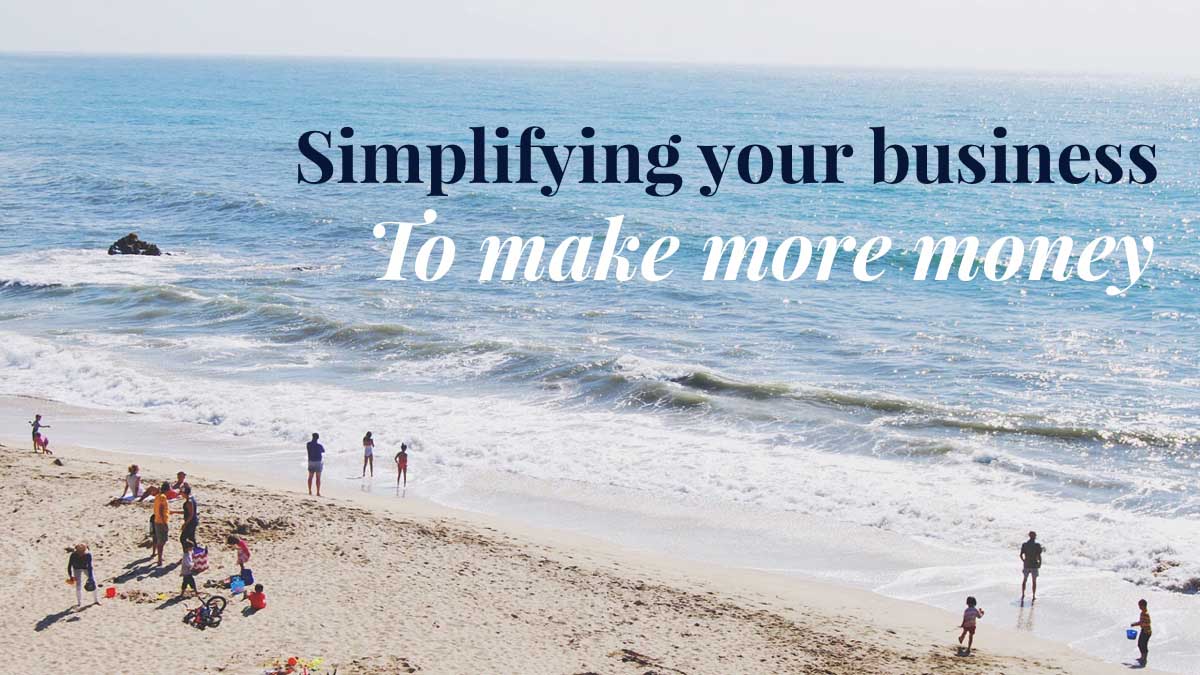I made all the mistakes in business so you don’t have to. Although after eight years in business, mistakes are somewhat inevitable. And I do like to double-check that something really didn’t work before I move on.
To celebrate the latest launch of The Non-Planner’s Business Plan free challenge, which kicks off on Monday, November 14, I’m sharing three ways to simplify your business. Because life’s short. And there are better things you could be doing than admin.
Not only will these cut down on your working hours, reduce your stress and throw overwhelm to the curb, they have the added bonus of increasing your income. Sounds too good to be true? Read on.
1: Get handy with your calculator
You may be ace at marketing. Perhaps you’re cultivating a large (and growing) community of gorgeous souls, sharing plenty of quality, useful, valuable and relevant information to equip and empower people. Your website may be shmick and your branding and photography world-class. But that all counts for naught if there’s a flaw in your business model.
It’s easy to let your business evolve over time with little conscious design by you, the CEO, and narry a calculator in sight. But now’s the time to pull up your CEO pants, pull some financial reports, and get handy with a calculator.
First, bring your accounts up-to-date (I use and recommend Xero, which makes it easy to stay on top of things with automated bank feeds). Now look at your sales: what did you earn money from over the last six or 12 months? What percentage of your total income did each offering bring in?
And, most importantly, what’s your profit?
Too many businesses fail because they don’t have enough offerings that are priced to give the business adequate profits to succeed.
What, if anything, are you selling that’s less than $100?
What, if anything, are you selling that’s around $300?
What, if anything, are you selling that’s around $1000?
What, if anything, are you selling that’s more than this?
You business model – how your business makes money – needs to make sense for you and your financial goals. It’s pointless as well as destructive to base your business model on somebody else’s. That $29 product you so admire from that online business guru you’ve never met? They likely spend several hundreds of thousands of dollars a year to promote it. Hopefully they’re handy with their calculator. So get busy with yours.

2: Be more generous with your marketing
To make more money in business, you need to be more generous with your marketing – and this will have the added benefit of assuaging any guilt you feel about saying no to requests for freebies or discounts (for friends, and friends of friends and their friends, too).
Your marketing should focus on providing ‘samplers’ – much like the free yoghurt in the supermarket. It’s a small amount of a product that’s you’re selling, which acts to give people a taste of your expertise, style and approach. Ideally, this should be digital, not face-to-face or one-to-one, so it doesn’t cost you anything (in theory) and it’s easily scaled.
Much like the free yoghurt sample, your freebie should lead somewhere. Supermarkets don’t give away samples for products that aren’t available to buy.
Look at what you’re selling and develop a sample of the first step. This shouldn’t be onerous, or expensive. It should take, at most, a few hours and cost a small proportion of what you’re ultimately hoping to make. Don’t spend $2000 developing a free video series for an online video course from which you’re hoping to make $5000.
People like things simplified (see title of this article), so checklists and short-‘n-sweet downloads can work really well. Just make sure you relate it to what you’re selling.
If your freebie downloads aren’t leading to anything (apart from growing your email list), fear not! I’ve created and given away plenty of free resources and trainings over the years that haven’t been attached to a sales funnel. You’re still growing your email list and community, sharing your expertise and positioning yourself as an authority. We all start somewhere.
Don’t get so good at marketing that you neglect to sell. Your profits fund your future marketing, so the more you sell, the more you can afford to be generous with your marketing (and ultimately, with developing and delivering a better offering).
Remember, nobody fills up on supermarket samples. If you want to help people, you need to sell to them so that they may experience the depth and breadth of what your business offers. And if they can’t afford you right now, they’ve got your awesome marketing gifts to keep them going until they can.
3: Stop worrying about technology
There are only two software tools you need to master as a small business owner: your website content management system (we design all our websites in WordPress) and your email marketing software (we use and sell Reach Mail).
That’s it.
Leadpages isn’t going to miraculously fill your coffers. Webinar Ninja isn’t going to put you on the front cover of Forbes magazine. Infusionsoft doesn’t mean you’ve officially “made it” in business. Expensive is not necessarily better.
Stop obsessing over tools. Choose a tool that does what you need it to do and move on. Facebook is filled with business owners wasting time comparing and contrasting software. Make a decision and move on.
While it’s important to continue to upgrade your tools as your business expands to support your growth (and keep admin to a minimum), technology is not the be-all-and-end-all. It’s supposed to be enabling, not distracting. As I’ve been banging on about for years, your message is far more important than your medium.
Focus on better understanding exactly who your business’s ideal client is, and what they need, and your message will become more magnetic and more urgent. Technology supports your message. Your message is the star. Or rather, your message should make your ideal clients feel like the star.
Your action list
- Does your most popular offering have enough profit margin or do you need to raise your price?
- Do you need to introduce a new, higher priced offering (or three)?
- Do you have freebie email opt-in gifts that correspond with what you’re selling?
- Do you have an automated email marketing funnel in place that connects your freebie email opt-in gift with the offering it relates to, with a clear call to purchase?
- Have you mastered your website software?
- Have you mastered your email marketing software?
- Do you need to upgrade or downgrade your existing software in line with your earnings and financial goals?






Refreshing article – thanks!